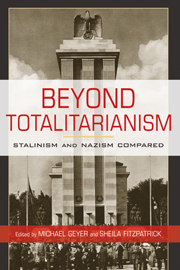4 - State Violence – Violent Societies
Published online by Cambridge University Press: 05 June 2012
Summary
COMPARING MASS VIOLENCE – APPROACH AND QUESTIONS
The academic book market certainly does not lack scholarly analyses comparing Nazism and Stalinism, and, many of these analyses address the issue of mass violence, the topic of this essay. The particularly sensitive nature of our topic and the controversial outcomes of past attempts to compare German and Soviet violence require some specific methodological reflections. On this basis, we try to contribute to a new and perhaps more conciliatory approach to the comparative history of violence.
Most existing studies on mass violence focus on the Soviet and German camp systems, usually reducing the great variety of camps to a select “representative” few on each side – namely, the concentration camps and the Gulag. Operated by the SS and the NKVD, respectively, these camp systems appear ideally suited for characterizing – even imagining – the “totalitarian” state. The focus of these studies is primarily on the methods of violence (again, reduced to a select few examples), the intensity or level of violence, the role of the state machinery in such violence, and the ideology upon which each respective state was based.
For a long time, little scholarly attention was paid to responsible perpetrators and functionaries. As many Soviet archival records have only recently become available, research on German perpetrators is somewhat more fully developed. Yet, even here, our concrete knowledge about perpetrator groups and individuals is sketchy, fragmentary, unbalanced, and still without a solid, agreed-upon theoretical framework.
- Type
- Chapter
- Information
- Beyond TotalitarianismStalinism and Nazism Compared, pp. 133 - 179Publisher: Cambridge University PressPrint publication year: 2008
References
- 4
- Cited by



